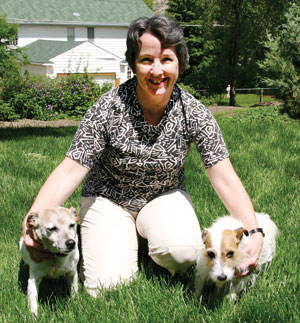
Wild animals in urban areas are always a risk to humans and pets, and this became abundantly clear to a local woman recently.
“Just when I turned around, a coyote was biting at his tail,” said Greene, adding the animal was only about 15 feet away at the time. “The dog yelped and I screamed at the coyote, and the coyote left.”
She put her dogs back on leash and walked up to the roadway to head home. She estimates the coyote continued to track her and her dogs for about a block and half.
“He was on the other side of the road in the trees staring at us,” she said.
While the run-in surprised her, it wasn’t all that unexpected. She said she saw one before on the trail this season, and a work colleague has seen coyotes in the area a handful of times this spring. A neighbour on Riverside Drive indicated he has also seen coyotes, and in fact, has noticed food in the bush, appearing as if someone is trying to feed the bunnies in the park.
Greene has since reported her run-in to Fish and Wildlife and suggests they should sign the area, especially for the sake of visitors who may not be familiar with the possibility of wildlife.
She said she often travels that path in the summer but since her run-in she has not returned.
“We hear them all the time yipping from across the river, and I have seen them in our alley before we had the new garbage cans. They would tip over garbage cans at night and you would see them eat, but this (encounter) was in broad daylight about 2:30 in the afternoon,” she said.
As populations grow and shift it is inevitable that man and wildlife will interact and coyotes have established themselves in urban areas.
According to the Alberta Sustainable Resources Development (SRD) website, control measures such as trapping and relocating coyotes are largely unsuccessful, and can be a risk to humans and pets When coyotes are removed, it can leave a vacancy for another population to move in, which could exacerbate the situation.
The reason that many animals such as coyotes settle in urban areas is the abundance of food sources such as garbage, rodents and pet food. One of the best way of minimizing contact is to limit reasons for a coyote to come near your property. This includes keeping a yard tidy and barriers in good order. This means sealing and stowing garbage securely, and taking garbage out only on collection day. Fallen fruit from trees or suet and seeds from bird feeders can attract rodents, which in turn attract coyotes who feed on the small animals. Allowing pets to run at large can also attract wildlife.
It is also important to protect children by spreading awareness, and supervising young children. Low branches on trees can provide a hiding place for coyotes or small animals, and could pose a risk near play areas.
Modern wildlife management, according to SRD, focuses on adverse conditioning, which essentially means making all animal-human encounters as unpleasant as possible for the animal, and notes this method only works if all people respond to coyotes aggressively, not allowing it to get comfortable around humans.
Respond to a coyote’s presence by making yourself appear large, waving your arms overhead and thrusting a long object, such as a walking stick towards the animal. A person should shout at the animal, maintain eye contact, and back away in a controlled manner, as turning and running may prompt a coyote into chasing.
“I’ll take a walking stick next time I go,” said Greene.
According to SRD if a person sees a coyote that is too sick or injured to move, or if a coyote is behaving in an aggressive manner, call the Alberta Fish and Wildlife in Drumheller at 403-823-1670.
















